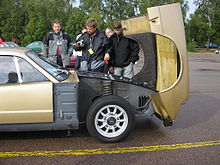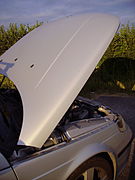Hood (car): Difference between revisions
No such user (talk | contribs) m No such user moved page Hood (vehicle) to Hood (car): WP:BOLD move for simplicity & consistency with Trunk (car), Pillar (car) |
No edit summary |
||
| Line 6: | Line 6: | ||
The '''hood''' (US and Canada) or '''bonnet''' (most Commonwealth countries) is the [[hinged]] [[lid (container)|cover]] over the [[engine]] of [[motor vehicle]]s that allows access to the engine compartment (or trunk on rear-engine and some mid-engine vehicles) for maintenance and [[auto mechanic|repair]]. In British terminology, ''hood'' refers to a fabric cover over the passenger compartment of the car (known as the 'top' in the US). In many motor vehicles built in the 1930s and 1940s, the resemblance to an actual hood or bonnet is clear when open and viewed head-on; in modern vehicles it continues to serve the same purpose but no longer resembles a head covering. |
The '''hood''' (US and Canada) or '''bonnet''' (most Commonwealth countries) is the [[hinged]] [[lid (container)|cover]] over the [[engine]] of [[motor vehicle]]s that allows access to the engine compartment (or trunk on rear-engine and some mid-engine vehicles) for maintenance and [[auto mechanic|repair]]. In British terminology, ''hood'' refers to a fabric cover over the passenger compartment of the car (known as the 'top' in the US). In many motor vehicles built in the 1930s and 1940s, the resemblance to an actual hood or bonnet is clear when open and viewed head-on; in modern vehicles it continues to serve the same purpose but no longer resembles a head covering. |
||
On passenger cars, a hood may be held down by a concealed latch. It is designed to protect a car from thefts, damage and sudden hood opening on the road. Hood release system is common on the most of vehicles and usually consists of interior hood latch handle, hood release cable and hood latch assembly. The hood latch handle is usually located below the steering wheel, beside the driver's seat or set into the door frame. When a driver pulls a hood latch handle the hood panel pops up and allows access to the engine compartment. On race cars or cars with aftermarket hoods (that do not use the factory latch system) the hood may be held down by hood pins. A hood may sometimes contain a [[hood ornament]], [[hood scoop]], [[power bulge]], and/or [[windscreen wiper|wiper]] jets. Hoods are typically made out of [[steel]], but [[aluminum]] is rapidly gaining popularity with auto companies. Aftermarket manufacturers may construct hoods out of [[fiberglass]], [[carbon fiber]], or dry carbon. |
On passenger cars, a hood may be held down by a concealed latch. It is designed to protect a car from thefts, damage and sudden hood opening on the road. Hood release system is common on the most of vehicles and usually consists of interior hood latch handle, hood release cable and hood latch assembly. The hood latch handle is usually located below the steering wheel, beside the driver's seat or set into the door frame. When a driver pulls a hood latch handle the hood panel pops up and allows access to the engine compartment. On race cars or cars with aftermarket hoods (that do not use the factory latch system) the hood may be held down by hood pins. Also, lighter aftermarket hoods are ted to fly open easily than factory hoods, especially when equipped with air scoops. That's why many aftermarket hood manufacturers recommend to use hood pins<ref>{{cite web|title=Hood Pins: Definitions, Selection, and Installation|url=https://www.carid.com/articles/hood-pins-definitions-selection-and-installation.html}}</ref>. A hood may sometimes contain a [[hood ornament]], [[hood scoop]], [[power bulge]], and/or [[windscreen wiper|wiper]] jets. Hoods are typically made out of [[steel]], but [[aluminum]] is rapidly gaining popularity with auto companies. Aftermarket manufacturers may construct hoods out of [[fiberglass]], [[carbon fiber]], or dry carbon. |
||
In [[Japan]] and [[Europe]], regulations have come into effect in recent years that place a limit on the severity of pedestrian head injury when struck by a motor vehicle. This is leading to more advanced hood designs, as evidenced by multicone hood inner panel designs as found on the [[Mazda RX-8]] and other vehicles. Other changes are being made to use the hood as an active structure and push its surface several centimeters away from the hard motor components during a pedestrian crash. This may be achieved by mechanical (spring force) or [[pyrotechnic]] devices. |
In [[Japan]] and [[Europe]], regulations have come into effect in recent years that place a limit on the severity of pedestrian head injury when struck by a motor vehicle. This is leading to more advanced hood designs, as evidenced by multicone hood inner panel designs as found on the [[Mazda RX-8]] and other vehicles. Other changes are being made to use the hood as an active structure and push its surface several centimeters away from the hard motor components during a pedestrian crash. This may be achieved by mechanical (spring force) or [[pyrotechnic]] devices. |
||
Revision as of 15:43, 1 November 2016
This article needs additional citations for verification. (March 2015) |

The hood (US and Canada) or bonnet (most Commonwealth countries) is the hinged cover over the engine of motor vehicles that allows access to the engine compartment (or trunk on rear-engine and some mid-engine vehicles) for maintenance and repair. In British terminology, hood refers to a fabric cover over the passenger compartment of the car (known as the 'top' in the US). In many motor vehicles built in the 1930s and 1940s, the resemblance to an actual hood or bonnet is clear when open and viewed head-on; in modern vehicles it continues to serve the same purpose but no longer resembles a head covering.
On passenger cars, a hood may be held down by a concealed latch. It is designed to protect a car from thefts, damage and sudden hood opening on the road. Hood release system is common on the most of vehicles and usually consists of interior hood latch handle, hood release cable and hood latch assembly. The hood latch handle is usually located below the steering wheel, beside the driver's seat or set into the door frame. When a driver pulls a hood latch handle the hood panel pops up and allows access to the engine compartment. On race cars or cars with aftermarket hoods (that do not use the factory latch system) the hood may be held down by hood pins. Also, lighter aftermarket hoods are ted to fly open easily than factory hoods, especially when equipped with air scoops. That's why many aftermarket hood manufacturers recommend to use hood pins[1]. A hood may sometimes contain a hood ornament, hood scoop, power bulge, and/or wiper jets. Hoods are typically made out of steel, but aluminum is rapidly gaining popularity with auto companies. Aftermarket manufacturers may construct hoods out of fiberglass, carbon fiber, or dry carbon.
In Japan and Europe, regulations have come into effect in recent years that place a limit on the severity of pedestrian head injury when struck by a motor vehicle. This is leading to more advanced hood designs, as evidenced by multicone hood inner panel designs as found on the Mazda RX-8 and other vehicles. Other changes are being made to use the hood as an active structure and push its surface several centimeters away from the hard motor components during a pedestrian crash. This may be achieved by mechanical (spring force) or pyrotechnic devices.
-
Some hoods may need a power bulge to fit for instance engine and air filters, or may enhance the aesthetic appearance of the hood
-
A flipfront hood
-
A hood hinged at the rear on a Saab 9-5



